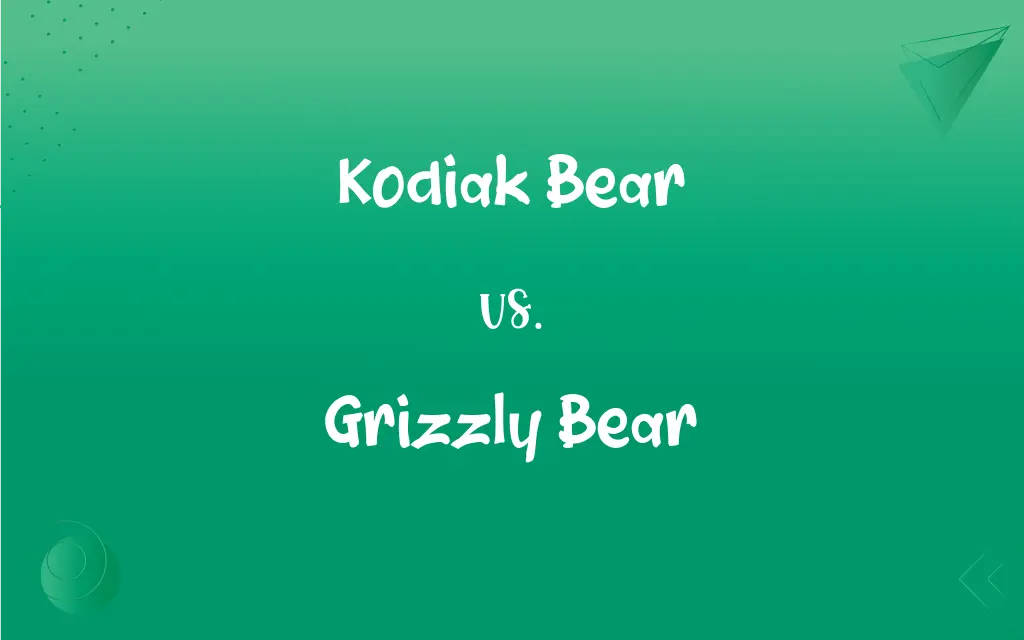Kodiak Bear vs. Grizzly Bear: What's the Difference?
Edited by Aimie Carlson || By Janet White || Published on July 24, 2024
Kodiak bears are a large subspecies of brown bear found on the Kodiak Archipelago, Alaska, while grizzly bears are a subspecies found across North America, generally smaller and less isolated.

Key Differences
The Kodiak bear and the grizzly bear are two of the most formidable members of the bear family, each with distinct characteristics that set them apart. The Kodiak bear is native to the Kodiak Archipelago in Alaska. These bears are among the largest of the bear species, with some males reaching weights of up to 1,500 pounds. Grizzly bears, on the other hand, are found in various parts of North America, including Alaska, parts of Canada, and the northwestern United States. While they can also reach significant sizes, with males weighing up to 1,000 pounds, they are generally smaller than their Kodiak counterparts.
Both Kodiak and grizzly bears are subspecies of the brown bear, but the Kodiak bear's isolation has led to it being considered a unique subspecies. This isolation has minimized genetic interchange with other bear populations, allowing for distinctive physical and genetic traits. In contrast, grizzly bears have a broader distribution and thus, a greater degree of genetic diversity. This diversity is reflected in their adaptability to different environments, ranging from coastal areas to mountainous regions.
Behaviorally, Kodiak bears tend to be less aggressive towards humans than grizzly bears, likely due to their limited interaction with humans and no history of being hunted to the same extent. However, both species will defend themselves if they feel threatened, especially when protecting cubs or a food source. The conservation status of both bears reflects the efforts made to protect their populations, with Kodiak bears being relatively stable due to their isolated habitat, while grizzly bears have been the focus of conservation efforts across their range.
Kodiak and grizzly bears share many similarities as subspecies of the brown bear, significant differences exist in their size, diet, distribution, and behavior. These differences are largely due to their geographical isolation and the varying ecosystems they inhabit, which have shaped their evolution over time.
Comparison Chart
Size
Larger, with males often exceeding 1,500 pounds
Smaller, with males weighing up to 1,000 pounds
ADVERTISEMENT
Distribution
Limited to the Kodiak Archipelago in Alaska
Found across North America, including Alaska, parts of Canada, and the northwestern United States
Diet
Primarily salmon, due to coastal habitat
More varied, including nuts, berries, fish, and small mammals
Genetic Diversity
Less diverse, due to geographical isolation
More diverse, due to a wider range of habitats
Human Interaction
Less aggressive towards humans
Can be more aggressive, especially in areas where they encounter humans more frequently
Kodiak Bear and Grizzly Bear Definitions
Kodiak Bear
Kodiak bears are known for their isolated habitat, leading to unique genetic characteristics.
Kodiak bears thrive in the solitude of the Kodiak Archipelago, away from human settlements.
ADVERTISEMENT
Grizzly Bear
Grizzly bears have a varied diet that adapts seasonally, from berries to fish.
In the fall, a grizzly bear might forage for berries for hours on end to prepare for winter.
Kodiak Bear
These bears have a diet heavily reliant on salmon, especially during the salmon run.
A Kodiak bear can consume up to several dozen pounds of salmon a day during peak season.
Grizzly Bear
A subspecies of brown bear known for its distinct grizzled fur and wide distribution across North America.
Grizzly bears roam vast territories, from mountain forests to coastal streams.
Kodiak Bear
Less aggressive towards humans, Kodiak bears generally avoid contact unless provoked.
Kodiak bears seldom pose a threat to humans, preferring to keep their distance unless disturbed.
Grizzly Bear
Known for their strength and agility, grizzly bears are formidable predators and scavengers.
A grizzly bear can easily overturn large rocks and logs while searching for food.
Kodiak Bear
Kodiak bears exhibit a relatively stable population due to their protected status and isolated environment.
Conservation efforts have ensured the Kodiak bear population remains healthy and sustainable.
Grizzly Bear
Grizzly bears can be more aggressive towards humans, particularly if surprised or when cubs are present.
Hikers are advised to carry bear spray in grizzly territory to deter potential attacks.
Kodiak Bear
A large subspecies of brown bear native to Alaska's Kodiak Archipelago.
The Kodiak bear's impressive size can be attributed to the abundant food sources on the islands.
Grizzly Bear
Conservation efforts have focused on protecting grizzly bear habitats and mitigating human-bear conflicts.
Through conservation, grizzly bear populations in certain areas have begun to recover.
FAQs
What conservation efforts are in place for grizzly bears?
Conservation efforts for grizzly bears include habitat protection, regulations on hunting, and initiatives to reduce human-bear conflicts.
How do grizzly bears adapt their diet seasonally?
Grizzly bears adapt their diet based on availability, eating more vegetation and insects in spring and summer, and shifting to higher-calorie foods like nuts and berries in the fall.
What distinguishes a Kodiak bear from a grizzly bear?
Kodiak bears are larger and found only in the Kodiak Archipelago, while grizzly bears have a broader distribution across North America.
Are Kodiak bears more aggressive than grizzly bears?
Generally, Kodiak bears are less aggressive towards humans compared to grizzly bears, partly due to their limited interactions with humans.
What role does salmon play in the diet of Kodiak bears?
Salmon is a crucial food source for Kodiak bears, especially during the salmon run, contributing significantly to their large size.
How does the diet of a Kodiak bear compare to that of a grizzly bear?
Kodiak bears primarily feed on salmon, whereas grizzly bears have a more varied diet that includes berries, nuts, and small mammals.
How does the genetic diversity of Kodiak bears compare to that of grizzly bears?
Kodiak bears have less genetic diversity due to their isolation, while grizzly bears, with a wider range, have greater genetic diversity.
What habitats do grizzly bears prefer?
Grizzly bears inhabit a range of habitats, from dense forests and alpine meadows to coastal areas.
Can Kodiak and grizzly bears interbreed?
While theoretically possible, their geographical separation makes natural interbreeding between Kodiak and grizzly bears highly unlikely.
What measures can be taken to safely coexist with grizzly bears?
Safe coexistence includes securing food sources, maintaining a safe distance, and carrying bear spray when in grizzly territory.
Why are Kodiak bears isolated to the Kodiak Archipelago?
The Kodiak Archipelago's isolation has led to the Kodiak bear becoming a distinct subspecies with unique genetic characteristics.
How do Kodiak bears interact with their environment?
Kodiak bears play a key role in their ecosystem, impacting local prey populations and vegetation through their feeding habits.
Are Kodiak bears considered endangered?
Kodiak bears are not considered endangered, thanks to successful conservation efforts on the Kodiak Archipelago.
What factors influence the population dynamics of grizzly bears?
Factors include food availability, habitat quality, human impact, and climate change.
How do grizzly bears contribute to ecosystem health?
Grizzly bears help maintain healthy ecosystems by controlling prey populations and facilitating nutrient distribution.
What is the social structure of Kodiak bears?
Kodiak bears are mostly solitary, except during mating season and when females are raising cubs.
What is the lifespan of a Kodiak bear in the wild?
Kodiak bears can live up to 20 years or more in the wild, depending on environmental conditions and food availability.
What challenges do grizzly bears face in their habitats?
Challenges include habitat loss, climate change, and conflicts with humans over resources.
What is the size range for adult Kodiak bears?
Adult male Kodiak bears can weigh up to 1,500 pounds, with females being smaller.
How do grizzly bears communicate with each other?
Grizzly bears communicate through vocalizations, body language, and scent marking to convey various messages.
About Author
Written by
Janet WhiteJanet White has been an esteemed writer and blogger for Difference Wiki. Holding a Master's degree in Science and Medical Journalism from the prestigious Boston University, she has consistently demonstrated her expertise and passion for her field. When she's not immersed in her work, Janet relishes her time exercising, delving into a good book, and cherishing moments with friends and family.
Edited by
Aimie CarlsonAimie Carlson, holding a master's degree in English literature, is a fervent English language enthusiast. She lends her writing talents to Difference Wiki, a prominent website that specializes in comparisons, offering readers insightful analyses that both captivate and inform.







































































